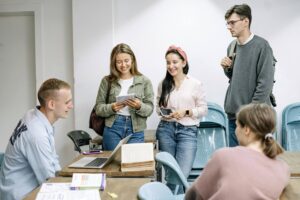Role Reveal 201: Exploring Interdisciplinary Collaboration
At a Glance
Discipline
- Interdisciplinary
- Health science
Instructional Level
- College & CEGEP
Course
- Physiotherapy Technology – 144-P41-DW
- Social Service – 388-215-DW
Tasks in Workflow
Social Plane(s)
- Group
- Whole Class
Type of Tasks
- Collecting & seeking information
- Discussing
Technical Details
Useful Technologies
- PowerPoint
Class size
- Small (20-49)
Time
- Multiple class periods (2-3 classes)
Instructional Purpose
- Preparation & knowledge activation
- Application & knowledge building
Overview
The aim of this activity is to have students from Physiotherapy Technology and Social Services showcase the way in which they excecute a patient interview by applying their learnings from the concept of Bio Psycho Social model. These different strategies will be compared and contrasted. This will allow students to understand how each profession fits in the overall care of a patient/client to appreciate what each profession brings to patient care.
In teams, students will be given a case and will need to come up with a list of questions to ask the patient. They will then complete a patient intervention.
This activity takes place in-class during the fourth semester. Since this activity takes place in second year, students have already participated in interdisciplinary activities. The strategy used is role-play which allows the students to work together as a team to provide a patient intervention.
Instructional Objectives
Students will be able to:
- Identify two new terms about the other profession’s approach to cleint interviews
- Identify some of the roles of the other profession when dealing with a client
- Identify types of questions other professions use to interview clients
- Identify overlapping and complementary aspects to gathering client information as part of a team
- Work together with a team to develop a list of intervention questions
Workflow & Materials

Activity Workflow
Applied Strategies
Related Activities
Published: 23/01/2024
Copyright: © 2024 Miller, Bulow, Dufour, Kuzmarov, MacMahon and Clegg. This is an open-access article distributed under the terms of the Creative Commons Attribution License (CC BY). The use, distribution or reproduction in other forums is permitted, provided the original author(s) and the copyright owner(s) are credited and that the original publication on this website is cited, in accordance with accepted academic practice. No use, distribution or reproduction is permitted which does not comply with these terms.



